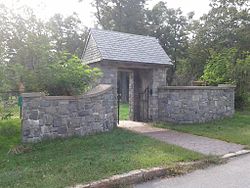| Western Cemetery | |
|---|---|
 The front gate to the Western Cemetery on Vaughan Street | |
 | |
| Details | |
| Established | 1829 |
| Location | |
| Country | United States |
| Coordinates | 43°38′44″N70°16′26″W / 43.6455°N 70.2740°W |
| Size | 12 acres (4.9 ha) |
| No. of graves | ~6,600 |
| Find a Grave | Western Cemetery |
| The Political Graveyard | Western Cemetery |

The Western Cemetery is an urban cemetery in Portland, Maine, United States. At one time Portland's home for the "poor and indigent", the cemetery is named for its location in city's West End neighborhood and proximity to the Western Promenade. Founded in the 18th century, the land was acquired by the city in 1829. In 1841, the city expanded the cemetery to its present 12 acres (4.9 ha). The Western Cemetery was Portland's primary cemetery from 1829 to 1852, when Evergreen Cemetery was established in the suburb of Deering. It was an active cemetery until 1910. [1] In October 2003, the cemetery began a restoration and reconstruction project was run by the Stewards of the Western Cemetery and the City of Portland and funded with municipal funds. [2]

